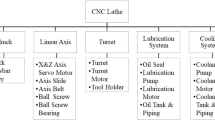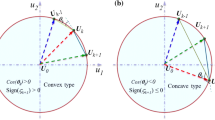Abstract
In view of the reliability design-related issues, a comprehensive robust design method which considers reliability allocation is proposed. According to the failure frequency information provided by a machine tool factory, the spindle system of lathe is selected to conduct failure mode and effects analysis (FMEA). Based on FMEA nonlinear third-order correction conversion function, by considering the correlation of failure mode, failure frequency and failure severity, a reliability allocation method of tandem system by Gumbel copula function is established. The reliability allocation method combines the Kendall τ correlation failure coefficient to obtain the reliability of each subsystem and then uses the Edgeworth series method of the fourth-order moment theory and the reliability of the subsystem obtained from the reliability allocation to optimize the important part of the subsystem. Take the lathe spindle system as an example. When t=500 h and the reliability of the spindle system is 0.999, the reliability allocation results of each subsystem with and without the correlation are calculated according to the proposed method. It is found that the reliability allocation value of each subsystem is lower than when correlation is not considered. This reflects the superiority of the method of considering failure correlation. Then, considering the reliability allocation results, the reliability robust design optimization of computer numerical control machine tool spindle is carried out, and the sensitivity analysis of the results is carried out. This method is based on the actual data of machine tool factory and comprehensively considers the integration of mechanical systems and the correlation between subsystems, and reduces the sensitivity of the variables to the maximum extent under the condition of the reliability of the subsystem. So, parts and overall system robustness are improved.










Similar content being viewed by others
Data availability
The test data used to support the findings of this study are included within the article. Readers can obtain data supporting the research results from the test data table in the paper.
References
Kai Y (1998) Robust design and reliability. Trans Nanjing Univ Aeronaut Astronaut (China) 15:9–15
Shoemaker AC, Tsui K-L, Wu CFJ (1991) Economical experimentation methods for robust design. Technometrics (USA) 33:415–427
Myers RH (1999) Response surface methodology-current status and future directions. J Qual Technol (USA) 31:30–44
Khattree R (1996) Robust parameter design: a response surface approach. J Qual Technol 28:187–198
Pregibon D (1984) Review: P. McCullagh, J. A. Nelder, Generalized Linear Models. Ann Stat 12:1589–1596
Xiaoping D, Wei C (2000) Towards a better understanding of modeling feasibility robustness in engineering design. J Mech Des 122:385–394
António CC, Hoffbauer LN (2009) An approach for reliability-based robust design optimisation of angle-ply composites. Compos Struct 90:53–59. https://doi.org/10.1016/j.compstruct.2009.01.008
Doh J, Yang Q, Raghavan N (2020) Reliability-based robust design optimization of polymer nanocomposites to enhance percolated electrical conductivity considering correlated input variables using multivariate distributions. Polymer 186:122060. https://doi.org/10.1016/j.polymer.2019.122060
Wu H, Zheng H, Li X, Wang W, Xiang X, Meng X (2020) A geometric accuracy analysis and tolerance robust design approach for a vertical machining center based on the reliability theory. Measurement 161:107809. https://doi.org/10.1016/j.measurement.2020.107809
Sriramdas V, Chaturvedi SK, Gargama H (2014) Fuzzy arithmetic based reliability allocation approach during early design and development. Expert Syst Appl 41:3444–3449. https://doi.org/10.1016/j.eswa.2013.10.048
Wang W, Xiong J, Xie M (2016) A study of interval analysis for cold-standby system reliability optimization under parameter uncertainty. Comput Ind Eng 97:93–100. https://doi.org/10.1016/j.cie.2016.04.017
Zhang E, Chen Q (2016) Multi-objective reliability redundancy allocation in an interval environment using particle swarm optimization. Reliab Eng Syst Saf 145:83–92. https://doi.org/10.1016/j.ress.2015.09.008
Chatwattanasiri N, Coit DW, Wattanapongsakorn N (2016) System redundancy optimization with uncertain stress-based component reliability: Minimization of regret. Reliab Eng Syst Saf 154:73–83. https://doi.org/10.1016/j.ress.2016.05.011
Gholinezhad H, Hamadani AZ (2017) A new model for the redundancy allocation problem with component mixing and mixed redundancy strategy. Reliab Eng Syst Saf 164:66–73. https://doi.org/10.1016/j.ress.2017.03.009
Chang K-H (2017) A more general reliability allocation method using the hesitant fuzzy linguistic term set and minimal variance OWGA weights. Appl Soft Comput 56:589–596. https://doi.org/10.1016/j.asoc.2016.07.008
Kim KO, Zuo MJ (2018) Optimal allocation of reliability improvement target based on the failure risk and improvement cost. Reliab Eng Syst Saf 180:104–110. https://doi.org/10.1016/j.ress.2018.06.024
Wang H, Zhang Y-M, Yang Z (2018) A reliability allocation method of CNC lathes based on copula failure correlation model. Chin J Mechan Eng 31:111. https://doi.org/10.1186/s10033-018-0303-9
Wang W, Lin M, Fu Y, Luo X, Chen H (2020) Multi-objective optimization of reliability-redundancy allocation problem for multi-type production systems considering redundancy strategies. Reliab Eng Syst Saf 193:106681. https://doi.org/10.1016/j.ress.2019.106681
Modibbo UM, Arshad M, Abdalghani O, Ali I (2021) Optimization and estimation in system reliability allocation problem. Reliab Eng Syst Saf 212:107620. https://doi.org/10.1016/j.ress.2021.107620
Chen Y, Ran Y, Wang Z, Li X, Yang X, Zhang G (2021) Meta-action reliability-based mechanical product optimization design under uncertainty environment. Eng Appl Artif Intell 100:104174. https://doi.org/10.1016/j.engappai.2021.104174
Chen R, Zhang C, Wang S, Qian Y (2021) Reliability estimation of mechanical seals based on bivariate dependence analysis and considering model uncertainty. Chin J Aeronaut 34:554–572. https://doi.org/10.1016/j.cja.2020.12.001
Sun B, Li Y, Wang Z, Yang D, Ren Y, Feng Q (2021) A combined physics of failure and Bayesian network reliability analysis method for complex electronic systems. Process Saf Environ Prot 148:698–710. https://doi.org/10.1016/j.psep.2021.01.023
Fu C, Sayed T (2021) Multivariate Bayesian hierarchical Gaussian copula modeling of the non-stationary traffic conflict extremes for crash estimation. Anal Meth Accid Res 29:100154. https://doi.org/10.1016/j.amar.2020.100154
Yan-Gang Z, Zhao-Hui L (2007) Fourth-moment standardization for structural reliability assessment. J Struct Eng 133:916–924
Lee BH (2001) Using Bayes belief networks in industrial FMEA modeling and analysis. In: Annual Reliability and Maintainability Symposium. 2001 Proceedings. International Symposium on Product Quality and Integrity (Cat. No.01CH37179), pp 7–15
Gupta G, Ghasemian H, Janvekar AA (2021) A novel failure mode effect and criticality analysis (FMECA) using fuzzy rule-based method: a case study of industrial centrifugal pump. Eng Fail Anal 123:105305. https://doi.org/10.1016/j.engfailanal.2021.105305
Yang Z, Zhu Y, Ren H, Zhang Y (2015) Comprehensive reliability allocation method for CNC lathes based on cubic transformed functions of failure mode and effects analysis. Chin J Mechan Eng 28:315–324
Huang M, Wang Q, Li Y, Ao L (2011) An approach for improvement of avionics reliability assessment based on copula theory. In: The Proceedings of 2011 9th International Conference on Reliability, Maintainability and Safety, pp 179–183
Fang G, Pan R, Hong Y (2020) Copula-based reliability analysis of degrading systems with dependent failures. Reliab Eng Syst Saf 193:106618. https://doi.org/10.1016/j.ress.2019.106618
Kim KO, Yang Y, Zuo MJ (2013) A new reliability allocation weight for reducing the occurrence of severe failure effects. Reliab Eng Syst Saf 117:81–88. https://doi.org/10.1016/j.ress.2013.04.002
Zhao Y-G, Ono T (2001) Moment methods for structural reliability. Struct Saf 23:47–75. https://doi.org/10.1016/S0167-4730(00)00027-8
Liu Y, Li T, Liu K, Zhang Y (2016) Chatter reliability prediction of turning process system with uncertainties. Mech Syst Signal Process 66–67:232–247. https://doi.org/10.1016/j.ymssp.2015.06.030
Zhao Y-G, Ono T (2004) On the problems of the fourth moment method. Struct Saf 26:343–347. https://doi.org/10.1016/j.strusafe.2003.10.001
Zhao Y-G, Lu Z-H (2007) Applicable range of the fourth–moment method for structural reliability. Architectural Institute of Japan, Architectural Institute of Korea, Architectural Society of China
Lu Z-H, Cai C-H, Zhao Y-G, Leng Y, Dong Y (2020) Normalization of correlated random variables in structural reliability analysis using fourth-moment transformation. Struct Saf 82:101888. https://doi.org/10.1016/j.strusafe.2019.101888
Ling C, Lu Z, Cheng K, Sun B (2019) An efficient method for estimating global reliability sensitivity indices. Probabilistic Eng Mech 56:35–49. https://doi.org/10.1016/j.probengmech.2019.04.003
Cadini F, Lombardo SS, Giglio M (2020) Global reliability sensitivity analysis by Sobol-based dynamic adaptive kriging importance sampling. Struct Saf 87:101998. https://doi.org/10.1016/j.strusafe.2020.101998
Zhou Y, Yimin Z, Xianzhen H et al (2013) Reliability-based robust optimization design of automobile components with nonnormal distribution parameters. Chin J Mech Eng 26:823–830. https://doi.org/10.3901/CJME.2013.04.823
Cai L, Zhang Z, Cheng Q et al (2016) An approach to optimize the machining accuracy retainability of multi-axis NC machine tool based on robust design. Precis Eng-J Int Soc Precis Eng Nanotechnol 43:370–386. https://doi.org/10.1016/j.precisioneng.2015.09.001
Kokkinos O, Papadopoulos V (2016) Robust design with Variability Response Functions; an alternative approach. Struct Saf 59:1–8. https://doi.org/10.1016/j.strusafe.2015.10.001
Funding
This work was supported by the Chinese National Natural Science Foundation (grant nos. U1710119, U1708254) and the Fundamental Research Funds for the Central Universities (N2003022).
Author information
Authors and Affiliations
Corresponding author
Ethics declarations
Conflict of interest
The authors declare no competing interests.
Additional information
Publisher’s note
Springer Nature remains neutral with regard to jurisdictional claims in published maps and institutional affiliations.
Rights and permissions
About this article
Cite this article
Yang, Z., Kou, M. Innovation fusion design of mechanical system robust design. Int J Adv Manuf Technol 124, 3795–3811 (2023). https://doi.org/10.1007/s00170-021-07843-4
Received:
Accepted:
Published:
Issue Date:
DOI: https://doi.org/10.1007/s00170-021-07843-4




